Performance Review Transformation at Adobe: A Comprehensive Case Study
VerifiedAdded on 2020/02/05
|10
|3086
|228
Case Study
AI Summary
This case study examines Adobe's transformation of its performance review system. It begins by exploring the reasons behind Adobe's shift away from traditional performance reviews, including the limitations of stack ranking and the need to align the review process with a changing business model focused on cloud services. The study then defines stack ranking, outlining its positive and negative impacts on both employees and the firm. It details Adobe's adoption of a 'check-in' process, comparing and contrasting it with the old method, and analyzes its effects on employee and manager performance. The case study also considers industries where the new approach might not be suitable and concludes by emphasizing the importance of aligning performance review methods with business objectives and fostering a collaborative work environment to improve productivity and employee engagement.
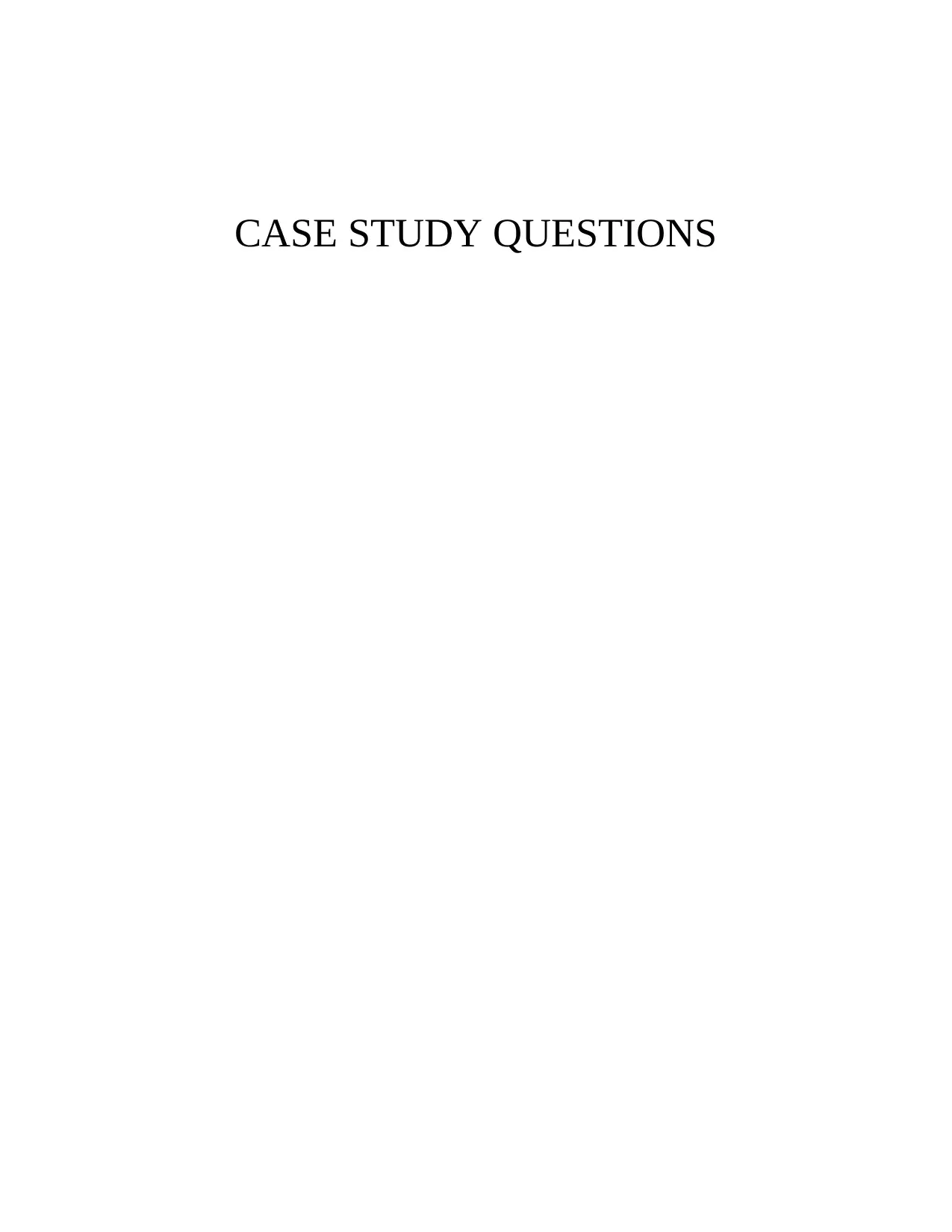
CASE STUDY QUESTIONS
Paraphrase This Document
Need a fresh take? Get an instant paraphrase of this document with our AI Paraphraser
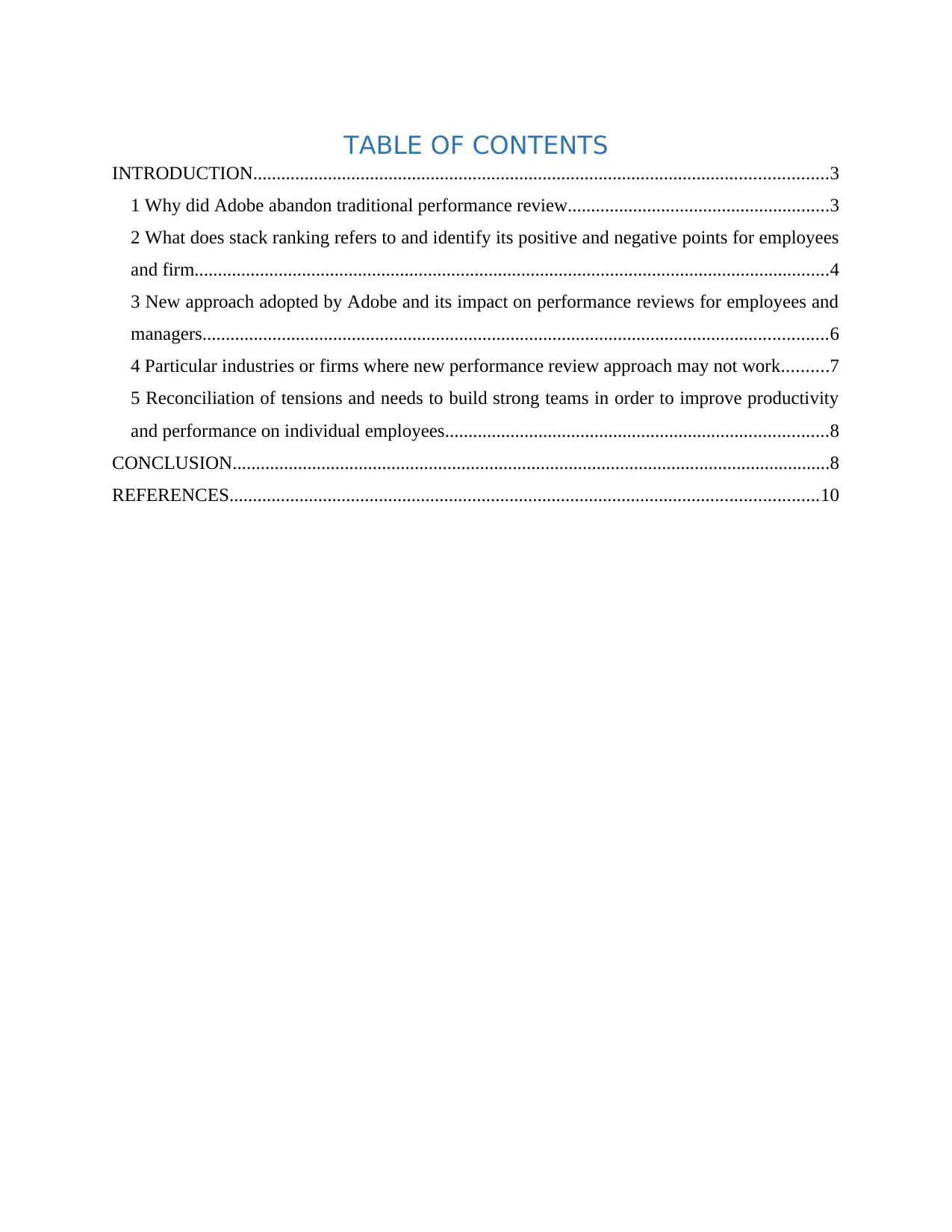
TABLE OF CONTENTS
INTRODUCTION...........................................................................................................................3
1 Why did Adobe abandon traditional performance review........................................................3
2 What does stack ranking refers to and identify its positive and negative points for employees
and firm........................................................................................................................................4
3 New approach adopted by Adobe and its impact on performance reviews for employees and
managers......................................................................................................................................6
4 Particular industries or firms where new performance review approach may not work..........7
5 Reconciliation of tensions and needs to build strong teams in order to improve productivity
and performance on individual employees..................................................................................8
CONCLUSION................................................................................................................................8
REFERENCES..............................................................................................................................10
INTRODUCTION...........................................................................................................................3
1 Why did Adobe abandon traditional performance review........................................................3
2 What does stack ranking refers to and identify its positive and negative points for employees
and firm........................................................................................................................................4
3 New approach adopted by Adobe and its impact on performance reviews for employees and
managers......................................................................................................................................6
4 Particular industries or firms where new performance review approach may not work..........7
5 Reconciliation of tensions and needs to build strong teams in order to improve productivity
and performance on individual employees..................................................................................8
CONCLUSION................................................................................................................................8
REFERENCES..............................................................................................................................10
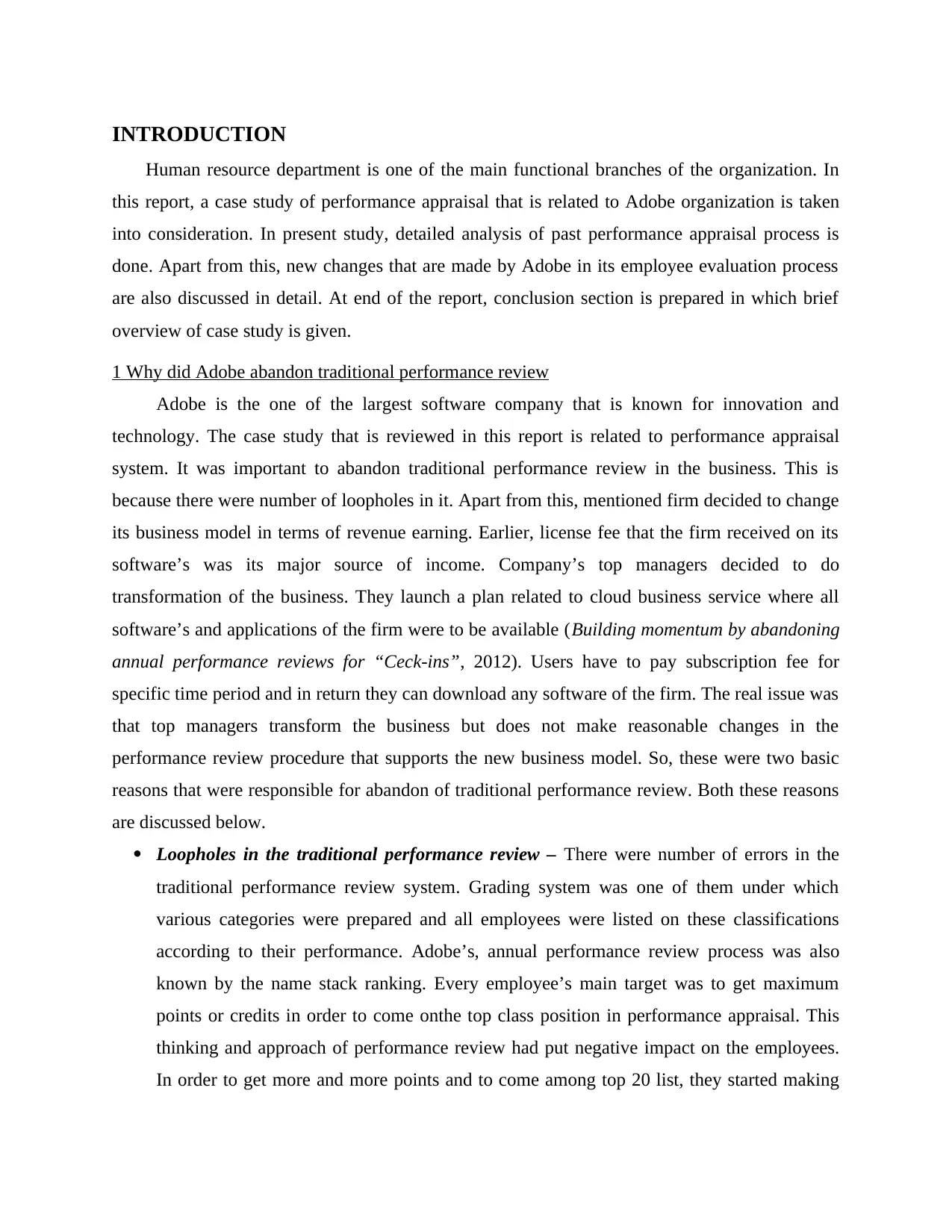
INTRODUCTION
Human resource department is one of the main functional branches of the organization. In
this report, a case study of performance appraisal that is related to Adobe organization is taken
into consideration. In present study, detailed analysis of past performance appraisal process is
done. Apart from this, new changes that are made by Adobe in its employee evaluation process
are also discussed in detail. At end of the report, conclusion section is prepared in which brief
overview of case study is given.
1 Why did Adobe abandon traditional performance review
Adobe is the one of the largest software company that is known for innovation and
technology. The case study that is reviewed in this report is related to performance appraisal
system. It was important to abandon traditional performance review in the business. This is
because there were number of loopholes in it. Apart from this, mentioned firm decided to change
its business model in terms of revenue earning. Earlier, license fee that the firm received on its
software’s was its major source of income. Company’s top managers decided to do
transformation of the business. They launch a plan related to cloud business service where all
software’s and applications of the firm were to be available (Building momentum by abandoning
annual performance reviews for “Ceck-ins”, 2012). Users have to pay subscription fee for
specific time period and in return they can download any software of the firm. The real issue was
that top managers transform the business but does not make reasonable changes in the
performance review procedure that supports the new business model. So, these were two basic
reasons that were responsible for abandon of traditional performance review. Both these reasons
are discussed below.
Loopholes in the traditional performance review – There were number of errors in the
traditional performance review system. Grading system was one of them under which
various categories were prepared and all employees were listed on these classifications
according to their performance. Adobe’s, annual performance review process was also
known by the name stack ranking. Every employee’s main target was to get maximum
points or credits in order to come onthe top class position in performance appraisal. This
thinking and approach of performance review had put negative impact on the employees.
In order to get more and more points and to come among top 20 list, they started making
Human resource department is one of the main functional branches of the organization. In
this report, a case study of performance appraisal that is related to Adobe organization is taken
into consideration. In present study, detailed analysis of past performance appraisal process is
done. Apart from this, new changes that are made by Adobe in its employee evaluation process
are also discussed in detail. At end of the report, conclusion section is prepared in which brief
overview of case study is given.
1 Why did Adobe abandon traditional performance review
Adobe is the one of the largest software company that is known for innovation and
technology. The case study that is reviewed in this report is related to performance appraisal
system. It was important to abandon traditional performance review in the business. This is
because there were number of loopholes in it. Apart from this, mentioned firm decided to change
its business model in terms of revenue earning. Earlier, license fee that the firm received on its
software’s was its major source of income. Company’s top managers decided to do
transformation of the business. They launch a plan related to cloud business service where all
software’s and applications of the firm were to be available (Building momentum by abandoning
annual performance reviews for “Ceck-ins”, 2012). Users have to pay subscription fee for
specific time period and in return they can download any software of the firm. The real issue was
that top managers transform the business but does not make reasonable changes in the
performance review procedure that supports the new business model. So, these were two basic
reasons that were responsible for abandon of traditional performance review. Both these reasons
are discussed below.
Loopholes in the traditional performance review – There were number of errors in the
traditional performance review system. Grading system was one of them under which
various categories were prepared and all employees were listed on these classifications
according to their performance. Adobe’s, annual performance review process was also
known by the name stack ranking. Every employee’s main target was to get maximum
points or credits in order to come onthe top class position in performance appraisal. This
thinking and approach of performance review had put negative impact on the employees.
In order to get more and more points and to come among top 20 list, they started making
⊘ This is a preview!⊘
Do you want full access?
Subscribe today to unlock all pages.

Trusted by 1+ million students worldwide
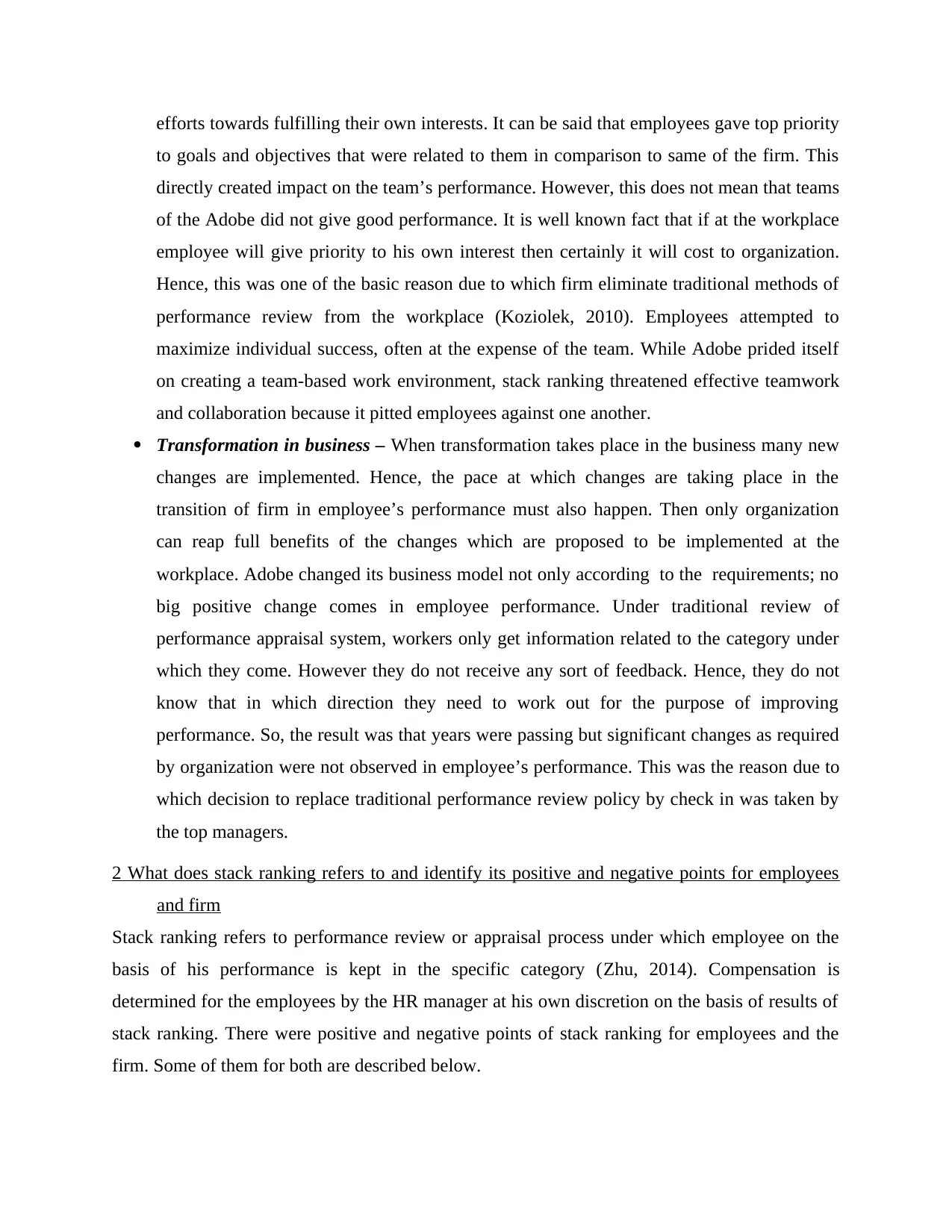
efforts towards fulfilling their own interests. It can be said that employees gave top priority
to goals and objectives that were related to them in comparison to same of the firm. This
directly created impact on the team’s performance. However, this does not mean that teams
of the Adobe did not give good performance. It is well known fact that if at the workplace
employee will give priority to his own interest then certainly it will cost to organization.
Hence, this was one of the basic reason due to which firm eliminate traditional methods of
performance review from the workplace (Koziolek, 2010). Employees attempted to
maximize individual success, often at the expense of the team. While Adobe prided itself
on creating a team-based work environment, stack ranking threatened effective teamwork
and collaboration because it pitted employees against one another.
Transformation in business – When transformation takes place in the business many new
changes are implemented. Hence, the pace at which changes are taking place in the
transition of firm in employee’s performance must also happen. Then only organization
can reap full benefits of the changes which are proposed to be implemented at the
workplace. Adobe changed its business model not only according to the requirements; no
big positive change comes in employee performance. Under traditional review of
performance appraisal system, workers only get information related to the category under
which they come. However they do not receive any sort of feedback. Hence, they do not
know that in which direction they need to work out for the purpose of improving
performance. So, the result was that years were passing but significant changes as required
by organization were not observed in employee’s performance. This was the reason due to
which decision to replace traditional performance review policy by check in was taken by
the top managers.
2 What does stack ranking refers to and identify its positive and negative points for employees
and firm
Stack ranking refers to performance review or appraisal process under which employee on the
basis of his performance is kept in the specific category (Zhu, 2014). Compensation is
determined for the employees by the HR manager at his own discretion on the basis of results of
stack ranking. There were positive and negative points of stack ranking for employees and the
firm. Some of them for both are described below.
to goals and objectives that were related to them in comparison to same of the firm. This
directly created impact on the team’s performance. However, this does not mean that teams
of the Adobe did not give good performance. It is well known fact that if at the workplace
employee will give priority to his own interest then certainly it will cost to organization.
Hence, this was one of the basic reason due to which firm eliminate traditional methods of
performance review from the workplace (Koziolek, 2010). Employees attempted to
maximize individual success, often at the expense of the team. While Adobe prided itself
on creating a team-based work environment, stack ranking threatened effective teamwork
and collaboration because it pitted employees against one another.
Transformation in business – When transformation takes place in the business many new
changes are implemented. Hence, the pace at which changes are taking place in the
transition of firm in employee’s performance must also happen. Then only organization
can reap full benefits of the changes which are proposed to be implemented at the
workplace. Adobe changed its business model not only according to the requirements; no
big positive change comes in employee performance. Under traditional review of
performance appraisal system, workers only get information related to the category under
which they come. However they do not receive any sort of feedback. Hence, they do not
know that in which direction they need to work out for the purpose of improving
performance. So, the result was that years were passing but significant changes as required
by organization were not observed in employee’s performance. This was the reason due to
which decision to replace traditional performance review policy by check in was taken by
the top managers.
2 What does stack ranking refers to and identify its positive and negative points for employees
and firm
Stack ranking refers to performance review or appraisal process under which employee on the
basis of his performance is kept in the specific category (Zhu, 2014). Compensation is
determined for the employees by the HR manager at his own discretion on the basis of results of
stack ranking. There were positive and negative points of stack ranking for employees and the
firm. Some of them for both are described below.
Paraphrase This Document
Need a fresh take? Get an instant paraphrase of this document with our AI Paraphraser
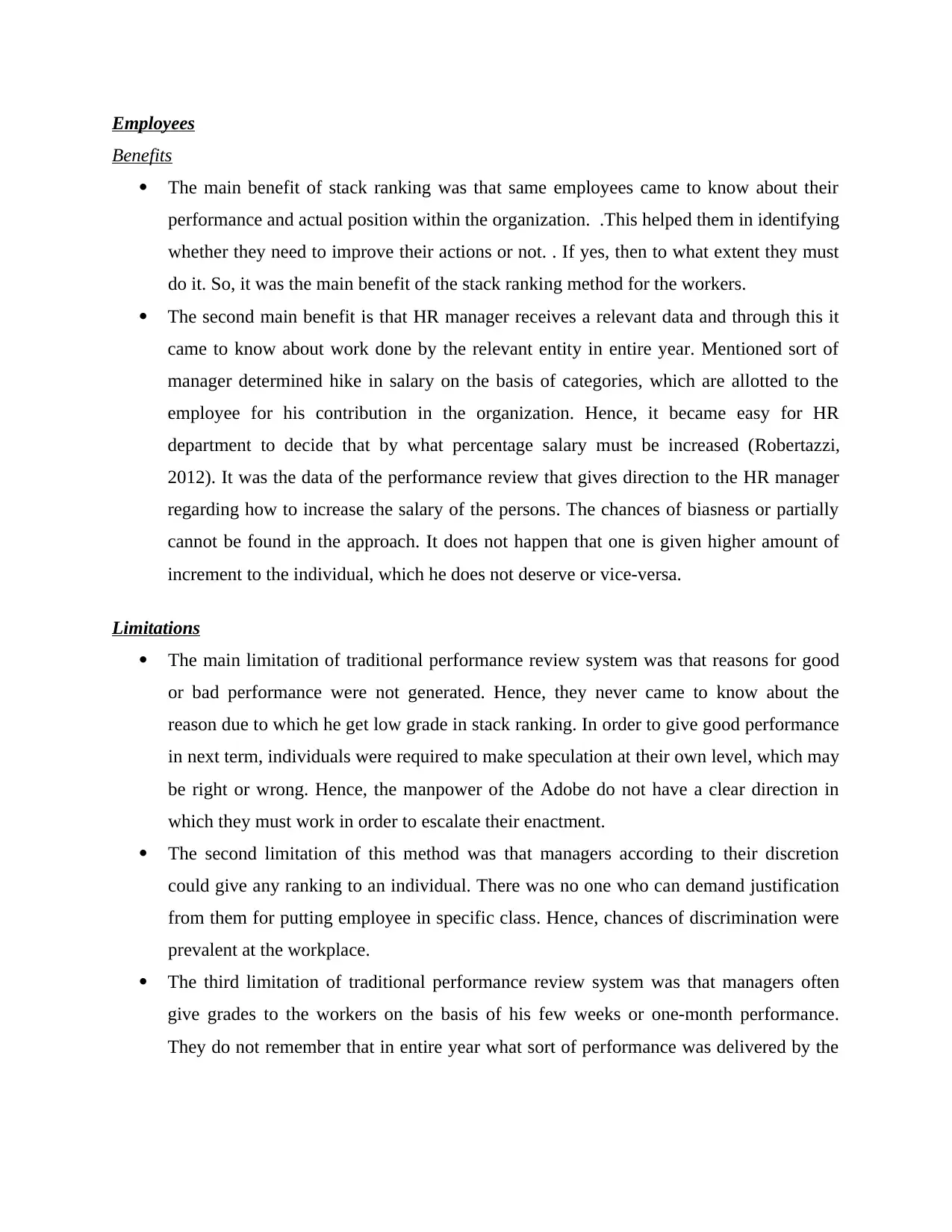
Employees
Benefits
The main benefit of stack ranking was that same employees came to know about their
performance and actual position within the organization. .This helped them in identifying
whether they need to improve their actions or not. . If yes, then to what extent they must
do it. So, it was the main benefit of the stack ranking method for the workers.
The second main benefit is that HR manager receives a relevant data and through this it
came to know about work done by the relevant entity in entire year. Mentioned sort of
manager determined hike in salary on the basis of categories, which are allotted to the
employee for his contribution in the organization. Hence, it became easy for HR
department to decide that by what percentage salary must be increased (Robertazzi,
2012). It was the data of the performance review that gives direction to the HR manager
regarding how to increase the salary of the persons. The chances of biasness or partially
cannot be found in the approach. It does not happen that one is given higher amount of
increment to the individual, which he does not deserve or vice-versa.
Limitations
The main limitation of traditional performance review system was that reasons for good
or bad performance were not generated. Hence, they never came to know about the
reason due to which he get low grade in stack ranking. In order to give good performance
in next term, individuals were required to make speculation at their own level, which may
be right or wrong. Hence, the manpower of the Adobe do not have a clear direction in
which they must work in order to escalate their enactment.
The second limitation of this method was that managers according to their discretion
could give any ranking to an individual. There was no one who can demand justification
from them for putting employee in specific class. Hence, chances of discrimination were
prevalent at the workplace.
The third limitation of traditional performance review system was that managers often
give grades to the workers on the basis of his few weeks or one-month performance.
They do not remember that in entire year what sort of performance was delivered by the
Benefits
The main benefit of stack ranking was that same employees came to know about their
performance and actual position within the organization. .This helped them in identifying
whether they need to improve their actions or not. . If yes, then to what extent they must
do it. So, it was the main benefit of the stack ranking method for the workers.
The second main benefit is that HR manager receives a relevant data and through this it
came to know about work done by the relevant entity in entire year. Mentioned sort of
manager determined hike in salary on the basis of categories, which are allotted to the
employee for his contribution in the organization. Hence, it became easy for HR
department to decide that by what percentage salary must be increased (Robertazzi,
2012). It was the data of the performance review that gives direction to the HR manager
regarding how to increase the salary of the persons. The chances of biasness or partially
cannot be found in the approach. It does not happen that one is given higher amount of
increment to the individual, which he does not deserve or vice-versa.
Limitations
The main limitation of traditional performance review system was that reasons for good
or bad performance were not generated. Hence, they never came to know about the
reason due to which he get low grade in stack ranking. In order to give good performance
in next term, individuals were required to make speculation at their own level, which may
be right or wrong. Hence, the manpower of the Adobe do not have a clear direction in
which they must work in order to escalate their enactment.
The second limitation of this method was that managers according to their discretion
could give any ranking to an individual. There was no one who can demand justification
from them for putting employee in specific class. Hence, chances of discrimination were
prevalent at the workplace.
The third limitation of traditional performance review system was that managers often
give grades to the workers on the basis of his few weeks or one-month performance.
They do not remember that in entire year what sort of performance was delivered by the
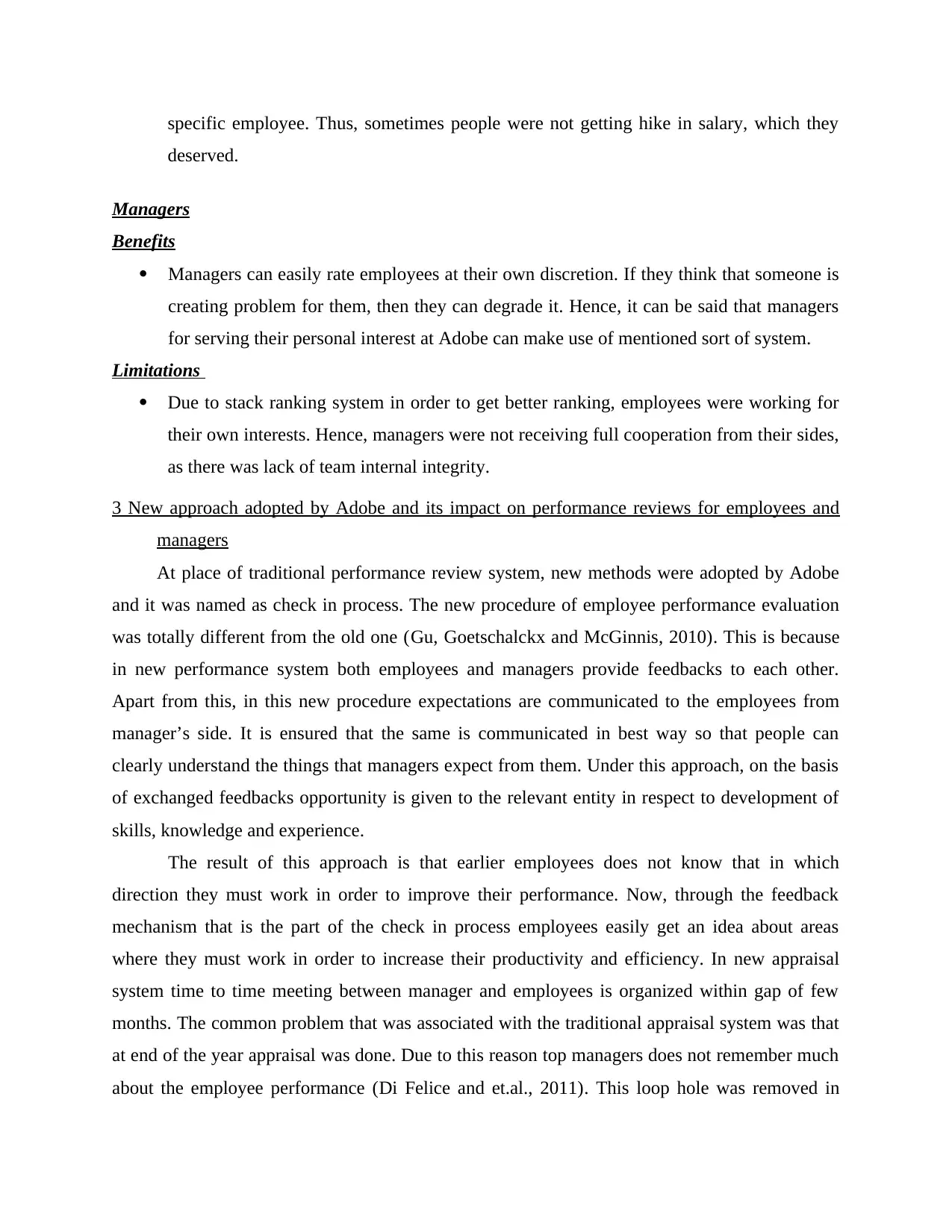
specific employee. Thus, sometimes people were not getting hike in salary, which they
deserved.
Managers
Benefits
Managers can easily rate employees at their own discretion. If they think that someone is
creating problem for them, then they can degrade it. Hence, it can be said that managers
for serving their personal interest at Adobe can make use of mentioned sort of system.
Limitations
Due to stack ranking system in order to get better ranking, employees were working for
their own interests. Hence, managers were not receiving full cooperation from their sides,
as there was lack of team internal integrity.
3 New approach adopted by Adobe and its impact on performance reviews for employees and
managers
At place of traditional performance review system, new methods were adopted by Adobe
and it was named as check in process. The new procedure of employee performance evaluation
was totally different from the old one (Gu, Goetschalckx and McGinnis, 2010). This is because
in new performance system both employees and managers provide feedbacks to each other.
Apart from this, in this new procedure expectations are communicated to the employees from
manager’s side. It is ensured that the same is communicated in best way so that people can
clearly understand the things that managers expect from them. Under this approach, on the basis
of exchanged feedbacks opportunity is given to the relevant entity in respect to development of
skills, knowledge and experience.
The result of this approach is that earlier employees does not know that in which
direction they must work in order to improve their performance. Now, through the feedback
mechanism that is the part of the check in process employees easily get an idea about areas
where they must work in order to increase their productivity and efficiency. In new appraisal
system time to time meeting between manager and employees is organized within gap of few
months. The common problem that was associated with the traditional appraisal system was that
at end of the year appraisal was done. Due to this reason top managers does not remember much
about the employee performance (Di Felice and et.al., 2011). This loop hole was removed in
deserved.
Managers
Benefits
Managers can easily rate employees at their own discretion. If they think that someone is
creating problem for them, then they can degrade it. Hence, it can be said that managers
for serving their personal interest at Adobe can make use of mentioned sort of system.
Limitations
Due to stack ranking system in order to get better ranking, employees were working for
their own interests. Hence, managers were not receiving full cooperation from their sides,
as there was lack of team internal integrity.
3 New approach adopted by Adobe and its impact on performance reviews for employees and
managers
At place of traditional performance review system, new methods were adopted by Adobe
and it was named as check in process. The new procedure of employee performance evaluation
was totally different from the old one (Gu, Goetschalckx and McGinnis, 2010). This is because
in new performance system both employees and managers provide feedbacks to each other.
Apart from this, in this new procedure expectations are communicated to the employees from
manager’s side. It is ensured that the same is communicated in best way so that people can
clearly understand the things that managers expect from them. Under this approach, on the basis
of exchanged feedbacks opportunity is given to the relevant entity in respect to development of
skills, knowledge and experience.
The result of this approach is that earlier employees does not know that in which
direction they must work in order to improve their performance. Now, through the feedback
mechanism that is the part of the check in process employees easily get an idea about areas
where they must work in order to increase their productivity and efficiency. In new appraisal
system time to time meeting between manager and employees is organized within gap of few
months. The common problem that was associated with the traditional appraisal system was that
at end of the year appraisal was done. Due to this reason top managers does not remember much
about the employee performance (Di Felice and et.al., 2011). This loop hole was removed in
⊘ This is a preview!⊘
Do you want full access?
Subscribe today to unlock all pages.

Trusted by 1+ million students worldwide
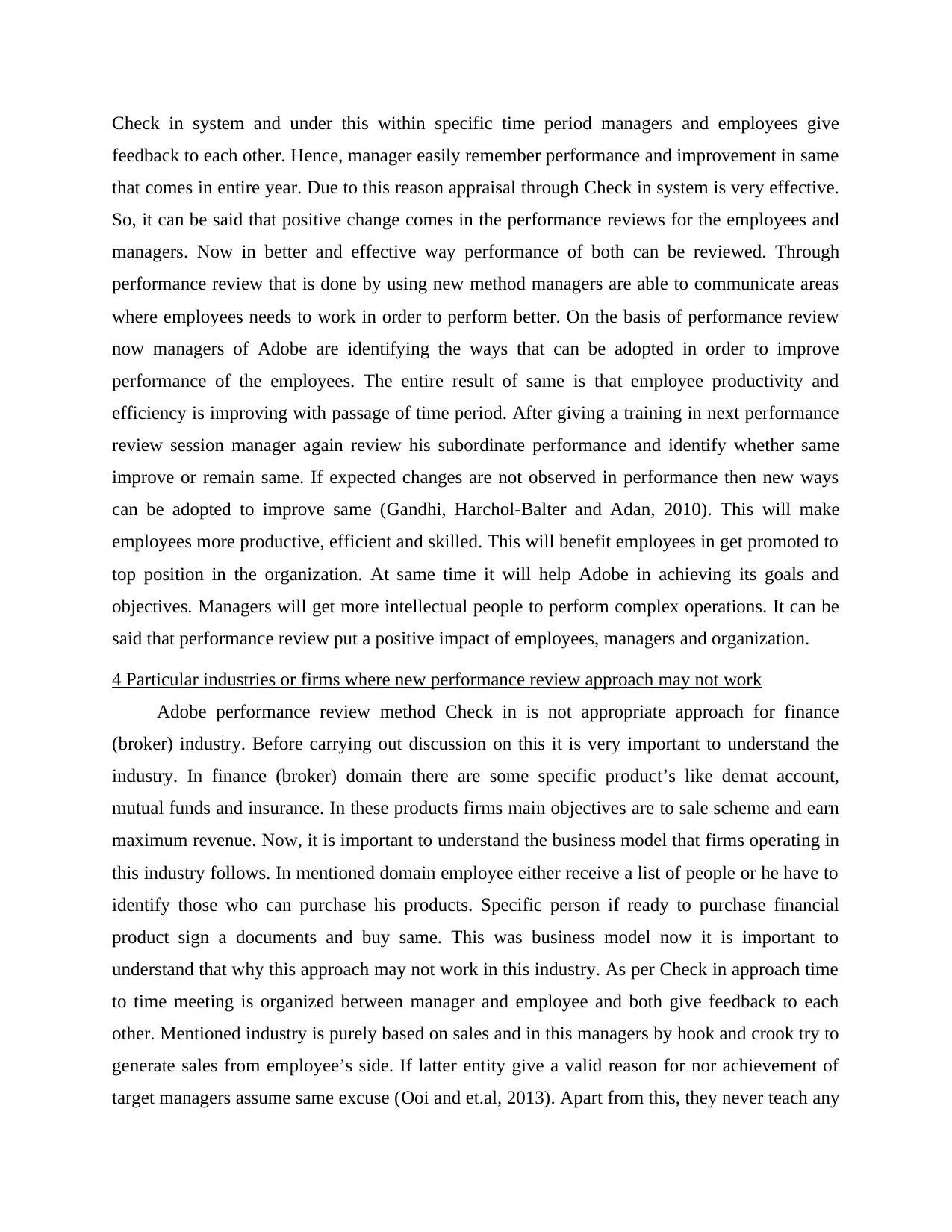
Check in system and under this within specific time period managers and employees give
feedback to each other. Hence, manager easily remember performance and improvement in same
that comes in entire year. Due to this reason appraisal through Check in system is very effective.
So, it can be said that positive change comes in the performance reviews for the employees and
managers. Now in better and effective way performance of both can be reviewed. Through
performance review that is done by using new method managers are able to communicate areas
where employees needs to work in order to perform better. On the basis of performance review
now managers of Adobe are identifying the ways that can be adopted in order to improve
performance of the employees. The entire result of same is that employee productivity and
efficiency is improving with passage of time period. After giving a training in next performance
review session manager again review his subordinate performance and identify whether same
improve or remain same. If expected changes are not observed in performance then new ways
can be adopted to improve same (Gandhi, Harchol-Balter and Adan, 2010). This will make
employees more productive, efficient and skilled. This will benefit employees in get promoted to
top position in the organization. At same time it will help Adobe in achieving its goals and
objectives. Managers will get more intellectual people to perform complex operations. It can be
said that performance review put a positive impact of employees, managers and organization.
4 Particular industries or firms where new performance review approach may not work
Adobe performance review method Check in is not appropriate approach for finance
(broker) industry. Before carrying out discussion on this it is very important to understand the
industry. In finance (broker) domain there are some specific product’s like demat account,
mutual funds and insurance. In these products firms main objectives are to sale scheme and earn
maximum revenue. Now, it is important to understand the business model that firms operating in
this industry follows. In mentioned domain employee either receive a list of people or he have to
identify those who can purchase his products. Specific person if ready to purchase financial
product sign a documents and buy same. This was business model now it is important to
understand that why this approach may not work in this industry. As per Check in approach time
to time meeting is organized between manager and employee and both give feedback to each
other. Mentioned industry is purely based on sales and in this managers by hook and crook try to
generate sales from employee’s side. If latter entity give a valid reason for nor achievement of
target managers assume same excuse (Ooi and et.al, 2013). Apart from this, they never teach any
feedback to each other. Hence, manager easily remember performance and improvement in same
that comes in entire year. Due to this reason appraisal through Check in system is very effective.
So, it can be said that positive change comes in the performance reviews for the employees and
managers. Now in better and effective way performance of both can be reviewed. Through
performance review that is done by using new method managers are able to communicate areas
where employees needs to work in order to perform better. On the basis of performance review
now managers of Adobe are identifying the ways that can be adopted in order to improve
performance of the employees. The entire result of same is that employee productivity and
efficiency is improving with passage of time period. After giving a training in next performance
review session manager again review his subordinate performance and identify whether same
improve or remain same. If expected changes are not observed in performance then new ways
can be adopted to improve same (Gandhi, Harchol-Balter and Adan, 2010). This will make
employees more productive, efficient and skilled. This will benefit employees in get promoted to
top position in the organization. At same time it will help Adobe in achieving its goals and
objectives. Managers will get more intellectual people to perform complex operations. It can be
said that performance review put a positive impact of employees, managers and organization.
4 Particular industries or firms where new performance review approach may not work
Adobe performance review method Check in is not appropriate approach for finance
(broker) industry. Before carrying out discussion on this it is very important to understand the
industry. In finance (broker) domain there are some specific product’s like demat account,
mutual funds and insurance. In these products firms main objectives are to sale scheme and earn
maximum revenue. Now, it is important to understand the business model that firms operating in
this industry follows. In mentioned domain employee either receive a list of people or he have to
identify those who can purchase his products. Specific person if ready to purchase financial
product sign a documents and buy same. This was business model now it is important to
understand that why this approach may not work in this industry. As per Check in approach time
to time meeting is organized between manager and employee and both give feedback to each
other. Mentioned industry is purely based on sales and in this managers by hook and crook try to
generate sales from employee’s side. If latter entity give a valid reason for nor achievement of
target managers assume same excuse (Ooi and et.al, 2013). Apart from this, they never teach any
Paraphrase This Document
Need a fresh take? Get an instant paraphrase of this document with our AI Paraphraser
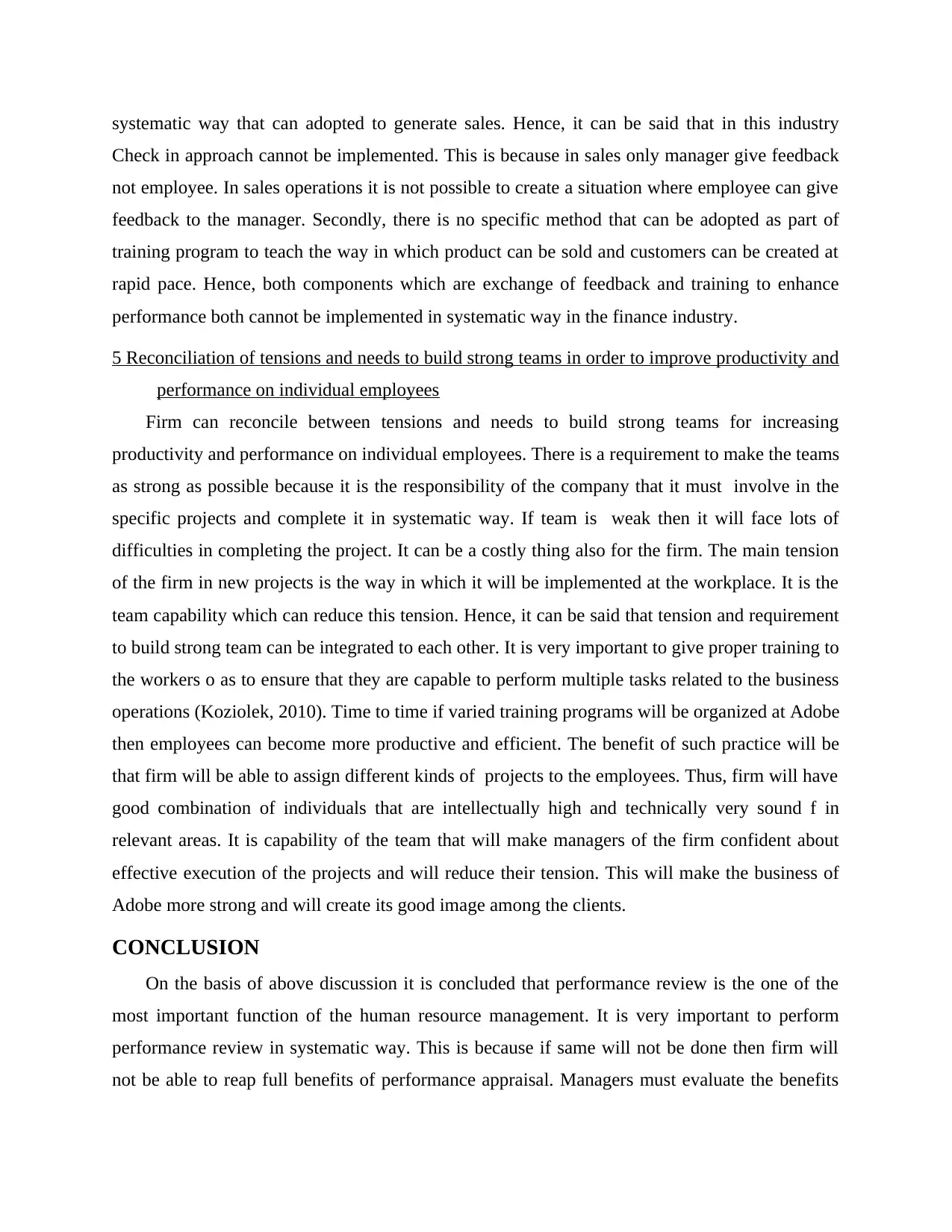
systematic way that can adopted to generate sales. Hence, it can be said that in this industry
Check in approach cannot be implemented. This is because in sales only manager give feedback
not employee. In sales operations it is not possible to create a situation where employee can give
feedback to the manager. Secondly, there is no specific method that can be adopted as part of
training program to teach the way in which product can be sold and customers can be created at
rapid pace. Hence, both components which are exchange of feedback and training to enhance
performance both cannot be implemented in systematic way in the finance industry.
5 Reconciliation of tensions and needs to build strong teams in order to improve productivity and
performance on individual employees
Firm can reconcile between tensions and needs to build strong teams for increasing
productivity and performance on individual employees. There is a requirement to make the teams
as strong as possible because it is the responsibility of the company that it must involve in the
specific projects and complete it in systematic way. If team is weak then it will face lots of
difficulties in completing the project. It can be a costly thing also for the firm. The main tension
of the firm in new projects is the way in which it will be implemented at the workplace. It is the
team capability which can reduce this tension. Hence, it can be said that tension and requirement
to build strong team can be integrated to each other. It is very important to give proper training to
the workers o as to ensure that they are capable to perform multiple tasks related to the business
operations (Koziolek, 2010). Time to time if varied training programs will be organized at Adobe
then employees can become more productive and efficient. The benefit of such practice will be
that firm will be able to assign different kinds of projects to the employees. Thus, firm will have
good combination of individuals that are intellectually high and technically very sound f in
relevant areas. It is capability of the team that will make managers of the firm confident about
effective execution of the projects and will reduce their tension. This will make the business of
Adobe more strong and will create its good image among the clients.
CONCLUSION
On the basis of above discussion it is concluded that performance review is the one of the
most important function of the human resource management. It is very important to perform
performance review in systematic way. This is because if same will not be done then firm will
not be able to reap full benefits of performance appraisal. Managers must evaluate the benefits
Check in approach cannot be implemented. This is because in sales only manager give feedback
not employee. In sales operations it is not possible to create a situation where employee can give
feedback to the manager. Secondly, there is no specific method that can be adopted as part of
training program to teach the way in which product can be sold and customers can be created at
rapid pace. Hence, both components which are exchange of feedback and training to enhance
performance both cannot be implemented in systematic way in the finance industry.
5 Reconciliation of tensions and needs to build strong teams in order to improve productivity and
performance on individual employees
Firm can reconcile between tensions and needs to build strong teams for increasing
productivity and performance on individual employees. There is a requirement to make the teams
as strong as possible because it is the responsibility of the company that it must involve in the
specific projects and complete it in systematic way. If team is weak then it will face lots of
difficulties in completing the project. It can be a costly thing also for the firm. The main tension
of the firm in new projects is the way in which it will be implemented at the workplace. It is the
team capability which can reduce this tension. Hence, it can be said that tension and requirement
to build strong team can be integrated to each other. It is very important to give proper training to
the workers o as to ensure that they are capable to perform multiple tasks related to the business
operations (Koziolek, 2010). Time to time if varied training programs will be organized at Adobe
then employees can become more productive and efficient. The benefit of such practice will be
that firm will be able to assign different kinds of projects to the employees. Thus, firm will have
good combination of individuals that are intellectually high and technically very sound f in
relevant areas. It is capability of the team that will make managers of the firm confident about
effective execution of the projects and will reduce their tension. This will make the business of
Adobe more strong and will create its good image among the clients.
CONCLUSION
On the basis of above discussion it is concluded that performance review is the one of the
most important function of the human resource management. It is very important to perform
performance review in systematic way. This is because if same will not be done then firm will
not be able to reap full benefits of performance appraisal. Managers must evaluate the benefits
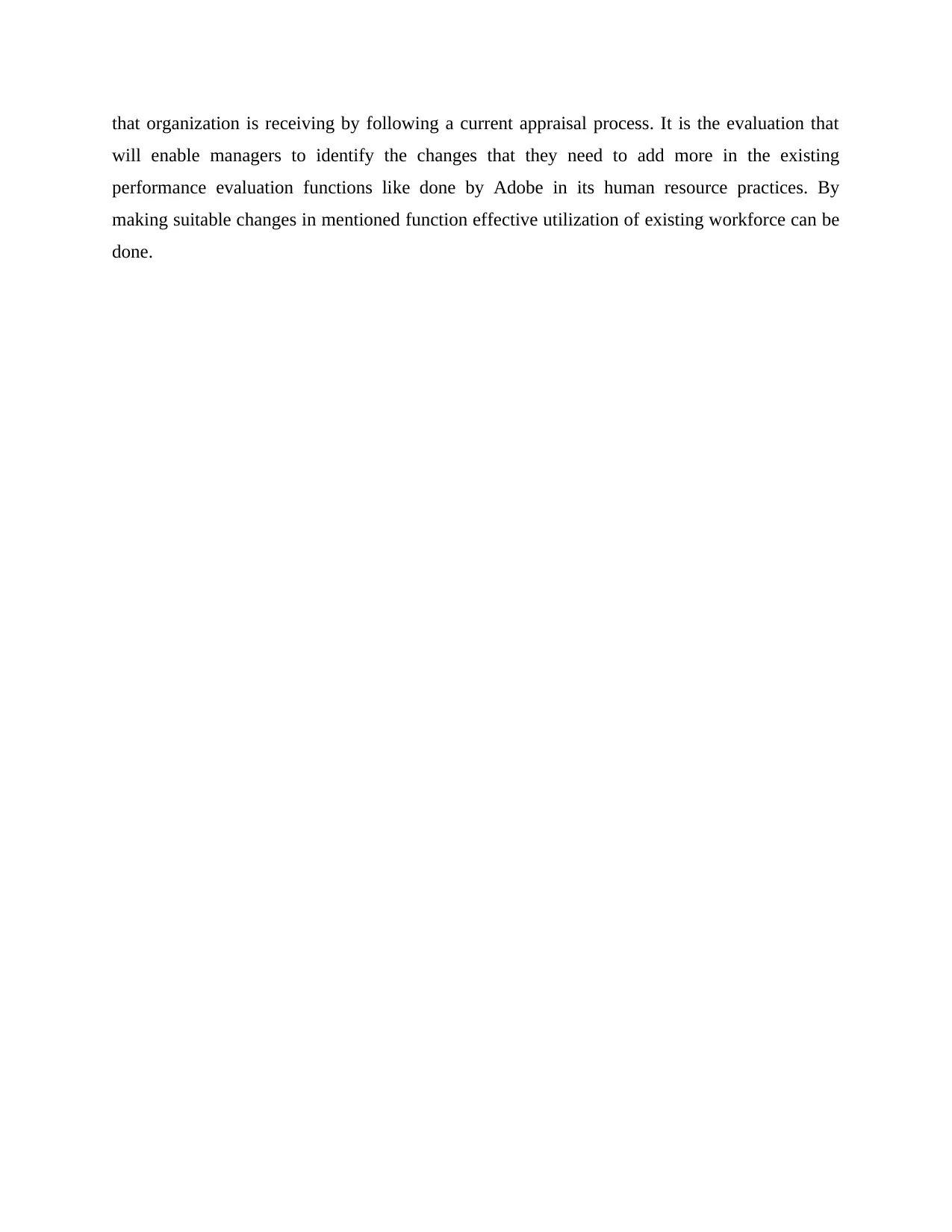
that organization is receiving by following a current appraisal process. It is the evaluation that
will enable managers to identify the changes that they need to add more in the existing
performance evaluation functions like done by Adobe in its human resource practices. By
making suitable changes in mentioned function effective utilization of existing workforce can be
done.
will enable managers to identify the changes that they need to add more in the existing
performance evaluation functions like done by Adobe in its human resource practices. By
making suitable changes in mentioned function effective utilization of existing workforce can be
done.
⊘ This is a preview!⊘
Do you want full access?
Subscribe today to unlock all pages.

Trusted by 1+ million students worldwide
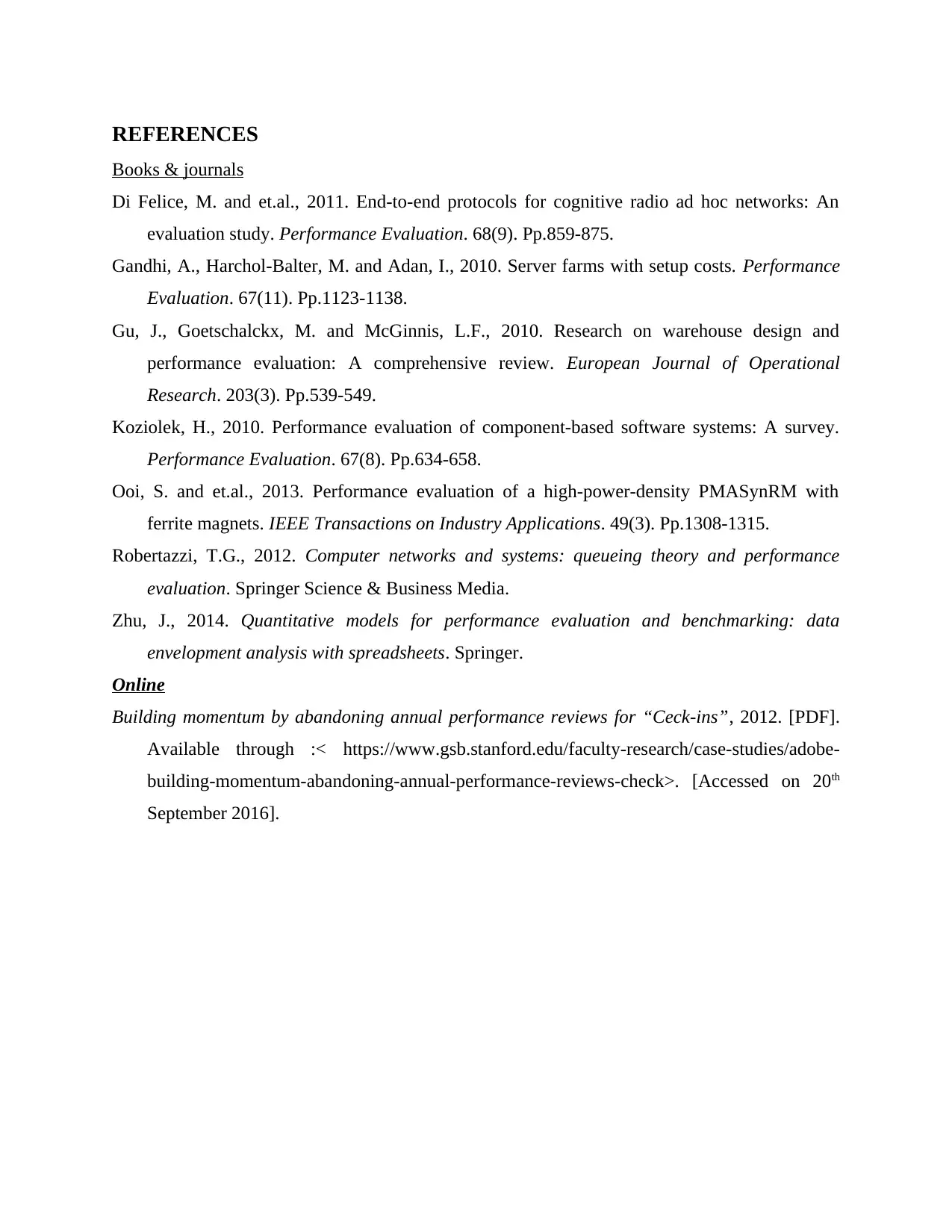
REFERENCES
Books & journals
Di Felice, M. and et.al., 2011. End-to-end protocols for cognitive radio ad hoc networks: An
evaluation study. Performance Evaluation. 68(9). Pp.859-875.
Gandhi, A., Harchol-Balter, M. and Adan, I., 2010. Server farms with setup costs. Performance
Evaluation. 67(11). Pp.1123-1138.
Gu, J., Goetschalckx, M. and McGinnis, L.F., 2010. Research on warehouse design and
performance evaluation: A comprehensive review. European Journal of Operational
Research. 203(3). Pp.539-549.
Koziolek, H., 2010. Performance evaluation of component-based software systems: A survey.
Performance Evaluation. 67(8). Pp.634-658.
Ooi, S. and et.al., 2013. Performance evaluation of a high-power-density PMASynRM with
ferrite magnets. IEEE Transactions on Industry Applications. 49(3). Pp.1308-1315.
Robertazzi, T.G., 2012. Computer networks and systems: queueing theory and performance
evaluation. Springer Science & Business Media.
Zhu, J., 2014. Quantitative models for performance evaluation and benchmarking: data
envelopment analysis with spreadsheets. Springer.
Online
Building momentum by abandoning annual performance reviews for “Ceck-ins”, 2012. [PDF].
Available through :< https://www.gsb.stanford.edu/faculty-research/case-studies/adobe-
building-momentum-abandoning-annual-performance-reviews-check>. [Accessed on 20th
September 2016].
Books & journals
Di Felice, M. and et.al., 2011. End-to-end protocols for cognitive radio ad hoc networks: An
evaluation study. Performance Evaluation. 68(9). Pp.859-875.
Gandhi, A., Harchol-Balter, M. and Adan, I., 2010. Server farms with setup costs. Performance
Evaluation. 67(11). Pp.1123-1138.
Gu, J., Goetschalckx, M. and McGinnis, L.F., 2010. Research on warehouse design and
performance evaluation: A comprehensive review. European Journal of Operational
Research. 203(3). Pp.539-549.
Koziolek, H., 2010. Performance evaluation of component-based software systems: A survey.
Performance Evaluation. 67(8). Pp.634-658.
Ooi, S. and et.al., 2013. Performance evaluation of a high-power-density PMASynRM with
ferrite magnets. IEEE Transactions on Industry Applications. 49(3). Pp.1308-1315.
Robertazzi, T.G., 2012. Computer networks and systems: queueing theory and performance
evaluation. Springer Science & Business Media.
Zhu, J., 2014. Quantitative models for performance evaluation and benchmarking: data
envelopment analysis with spreadsheets. Springer.
Online
Building momentum by abandoning annual performance reviews for “Ceck-ins”, 2012. [PDF].
Available through :< https://www.gsb.stanford.edu/faculty-research/case-studies/adobe-
building-momentum-abandoning-annual-performance-reviews-check>. [Accessed on 20th
September 2016].
1 out of 10
Related Documents
Your All-in-One AI-Powered Toolkit for Academic Success.
+13062052269
info@desklib.com
Available 24*7 on WhatsApp / Email
![[object Object]](/_next/static/media/star-bottom.7253800d.svg)
Unlock your academic potential
Copyright © 2020–2025 A2Z Services. All Rights Reserved. Developed and managed by ZUCOL.




